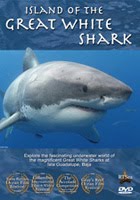One shark species that I had not had the pleasure of seeing face-to-face, was the oceanic whitetip. This shark is a pelagic predator, which is to say that it spends most of its time in open water, far away from shore. It has the reputation of being in the top four of the most dangerous sharks (along with the great white, tiger, and bull shark) as it was typically associated with shark attacks during World War II following the sinking of ships in tropic waters.
Epic Diving, based in New Jersey and operating for four to five months out of the year at Cat Island in the Bahamas, has made a specialty of diving with oceanic whitetips. During the spring, these sharks seem to migrate to the island, primarily staying in the deep drop-offs that surround the island. The Cape Eleuthra Institute has been tagging and studying these sharks to try to determine the whys and wheres of their migration. It's still not fully understood, but their springtime sojorn to Cat Island affords divers the opportunity to see these beautiful sharks, with their distinctive rounded, snow-capped dorsal and long pectoral fins.
For this trip, I was trying out a new camera rig. I typically shoot video with a Sony EX-3 with a nanoFlash external recorder. This provides me with broadcast quality, 4-2-2 footage (unless my client wants to shoot with something higher up the food chain like a RED Epic) and it has served me well for many years. The drawback is that it requires a rather large housing which is great for stability but not so much fun when you need to be more mobile - like chasing after a whale shark or maneuvering to catch a shot of schooling tuna or jacks.
So here, I was breaking in a Canon 5D Mk III with Sea & Sea YS-D1 strobes and Light & Motion Sola 4000 video lights. In addition to taking great still pictures, the Canon 5D Mk III also shoots terrific video. This has made it a popular camera with independent filmmakers as it delivers a film-like range in depth of field with a variety of lenses at the filmmaker's disposal. For me, that versatility was attractive for both topside and underwater shoots, but it also provides me with a smaller package to push through the water.
Slipping into the water with a new species of shark always gets the adrenaline pumping and this first day of the expedition proved to be no exception. We found ourselves being visited by five or six very curious oceanic whitetips. These sharks cruised the surface so scuba gear wasn't necessary, just freediving (mask, snorkel & fins). As Vincent Canabal of Epic Diving instructed us in our pre-dive safety briefing, it was important to keep an eye on the sharks around you or you could get bumped. Photographers and videographers can get wrapped up in looking through the viewfinder, setting up or waiting for that perfect shot. But in the world of shark diving that can be a very limiting view of what is truly going on around you.
Oceanic whitetips are beautiful sharks. Elegant with distinctive markings, they move at a very relaxed pace and, for the filmmakers and photographers, they are very accommodating. Their curiosity takes them from one diver to another, coming straight at you and then drawn to their own reflected image in your camera dome. You often would find yourself having to nudge them away at the last moment for fear that they would brush up against your dome lens port with their rough skin (my acrylic fisheye dome port suffered a few abrasions which I was able to buff out, fortunately).
While getting eye-to-eye closeups with these magnificent sharks is always exciting, one of my favorite still photographs from the expedition was one that captured the solitary existence of this pelagic predator who spends its life cruising through the endless blue.
Tragically, the curious nature of the oceanic whitetip, combined with its preference for open water, has made it a target for commercial shark fishing boats that ply international waters - right in the oceanic whitetip's backyard. The IUCN (International Union for the Conservation of Nature) lists the oceanic whitetip on its Red List as "vulnerable" to extinction and that its population trend is decreasing. The recent world meeting of CITES (Convention on International Trade of Endangered Species) resulted in having the oceanic whitetip placed on CITES' Appendix II, which is a first step in monitoring and ultimately regulating the trade in this particular species. Hopefully, such steps will be in time before the oceanic whitetip's population reaches a tipping point wherein its inability to replenish its numbers faster than the rate of extraction causes an irreversible collapse.
My thanks to Vin and Debbie Canabal of Epic Diving for a first-rate operation. And a special thanks to Amanda Cotton who was there to provide a photo workshop and advice to all the divers. Playing with new toys, it's always great to have someone to turn to who is so accomplished in her field.
Photos copyright 2013 by Richard Theiss/RTSea Media
Source: Epic Diving
Source ACottonPhoto.com



















No comments:
Post a Comment